Napier: Experience a preserved moment in time in the art-deco capital
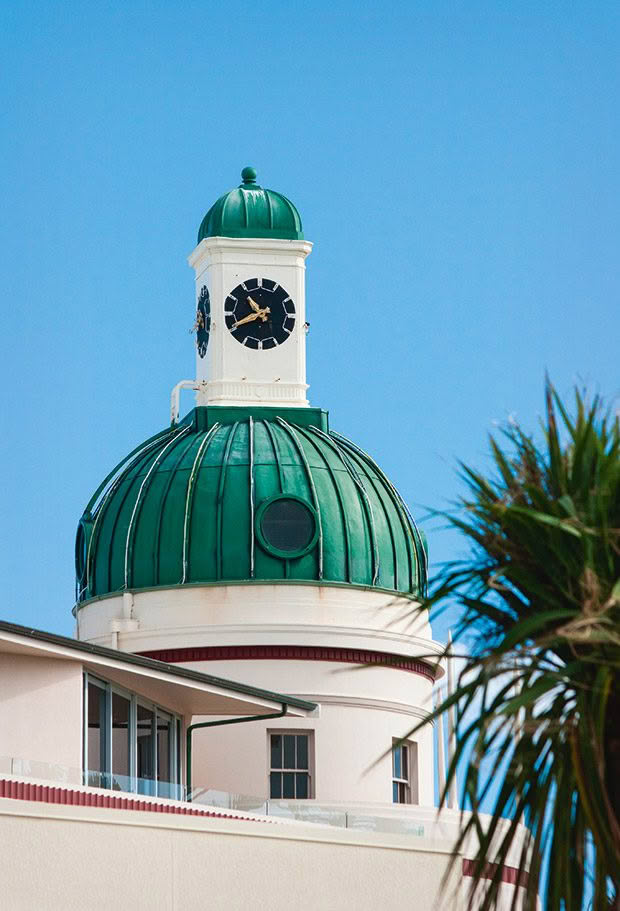
Built in 1936, the iconic Temperance & General Building, with its verdigris dome top, occupies a corner lot on Marine Parade. It’s currently home to the Dome boutique hotel and Lone Star café.
Thanks to exhibitions about the 1931 earthquake and the return of the city’s popular art deco festival, Napier continues to keep its past, present and future.
Words and photos: Chris van Ryn
There’s an aroma of salt and a sharp sea breeze as I step onto the pier. Images of destruction and chaos linger in my mind.
“I can see it all now. Oh! It was terrible — the shrieks of the wounded. The moaning of the dying and the terror in the eyes of the girls.”
The pier is modern and minimalist, a sharp-edged rectangle raised on columns where it steps into high-energy waves. It makes a striking sculptural statement among the grey pebbles and strewn driftwood. When I reach the end, I gaze at the uninterrupted panorama of water.
This is the Pacific Ocean, and it feels vast and wild to me — a surging untameable rawness. The seabed drops dramatically, arcing towards the deep.
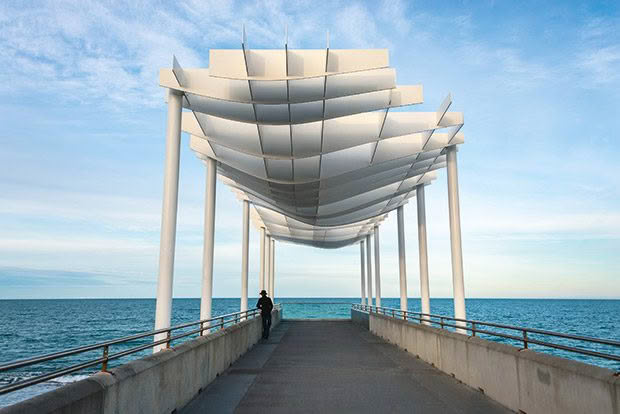
Nicknamed the Viewing Platform, the pier was constructed in late 2015, initially as an innovative drainage cover. Despite some early discontent by locals, hundreds have strolled along its length to take selfies, view the waters at sunrise, or even the occasional whale.
Some 130 kilometres off shore is the gigantic Hikurangi subduction zone, part of the Pacific fault line. A catastrophic rupture of the tectonic plates flattened the city behind me: Napier. “…the air was full of dust from the falling buildings, people huddled together weeping and moaning. I thought the world had come to an end.”
Minutes earlier, I’d emerged from an earthquake exhibition at Tai Ahuriri (Hawke’s Bay Museum & Art Gallery). The area was an envelope of dark. When my eyes adjusted, the surrounding shadows transformed into displays. Somewhere was the sound of beeping, insistent, urgent, like Morse code. Spotlights sliced the dark, illuminating images of imploded buildings and people trawling through mountains of rubble. And there were panels with dramatic quotes from survivors, people in despair who thought the world was about to end.
The year was 1931, and although it felt like it, the world had not ended. The earthquake lasted 190 seconds at the cost of 256 lives, 161 in Napier. We know exactly when it started: 10.47am because that’s when the clock stopped in the rotunda.
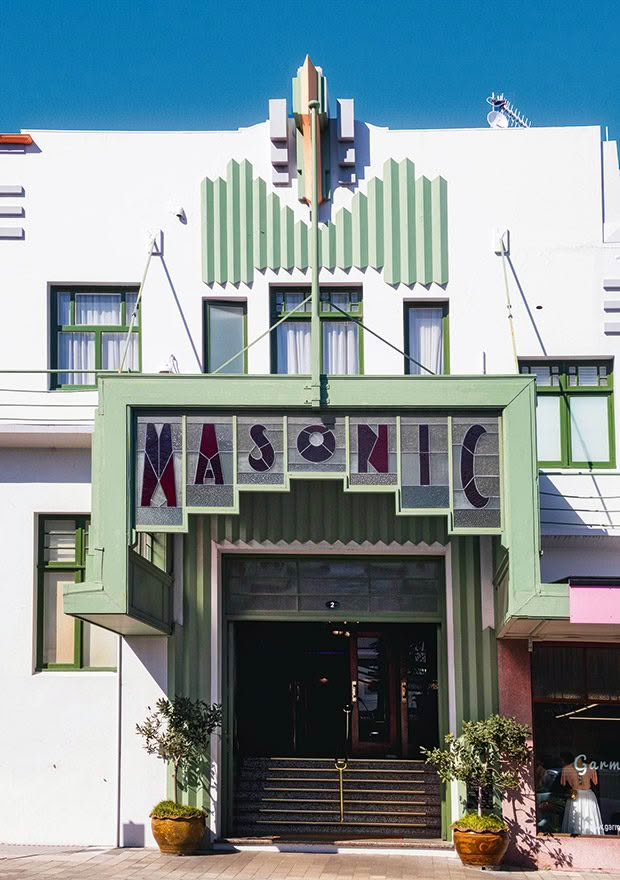
Designed by Wellington Architect W.J. Prowse and constructed in 1932, the Masonic Hotel is appropriate for an art deco weekend.
And what arose from the debris and destruction? The seeds of rebirth and re-creation. One need only set foot in Napier to sense there is something poetic in the air. Its enchanting, slightly surreal, time-warped charms that tourists flock to in the high season came into being because of the quake: the city found its reincarnation in an aesthetic that originated in France in the mid- to late- 1910s: art deco.
In so doing, it shrugged off its colonial aesthetic, departing from the Edwardian baroque and Victorian architecture prevalent throughout New Zealand. Napier was not just rebuilt; it was reimagined.
Below the pier, smooth grey pebbles roll back and forth with the waves, catching my attention for the story they tell. Over millennia, the seas have transported rocks from the nearby cliffs: the pale-faced Cape Kidnappers (Te Kauwae-a-Māui) with colonies of gannets, whitewashing the cliff tops with their guano.
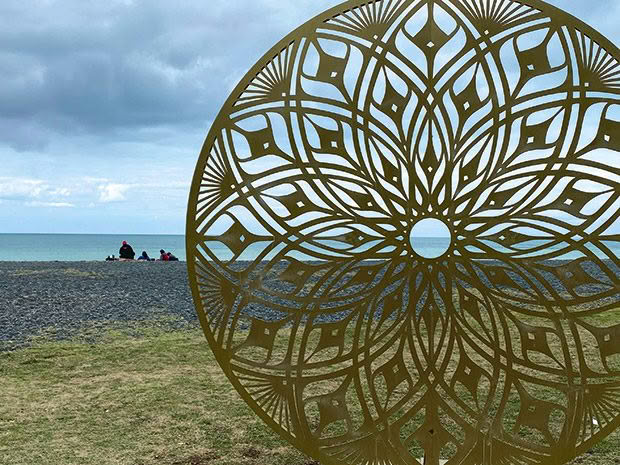
Sunscope is an art deco-inspired piece by sculptor Ant van Dorsten positioned to capture the sunrise through the eye of the scope.
And at the nearby Mangaone Cliffs, the endless swirling waters of the Pacific grind the rocks into smooth elliptical pebbles and transport them to nearby coastlines. Maybe in a thousand years, this will all be sand.
The moon appears, the white crescent edge of a fingernail, while a foggy sun is still in the throes of disappearing. Nearby, a serpentine path set into a grass verge abuts a landscaped area with water features and sculptures, a basketball ‘rink’ and a curvaceous concrete skateboarding area neatly interwoven into planters. It’s a skateboard park — and yet —it’s not.
At first glance, something appears as a gigantic, forlorn piece of playground equipment. It’s a stainless-steel disc mounted on the centre of a half-round blue pipe. To my surprise, it’s a sculpture that anchors the location on the horizon where the sun rose 22 years ago, on the first day of the new millennium.
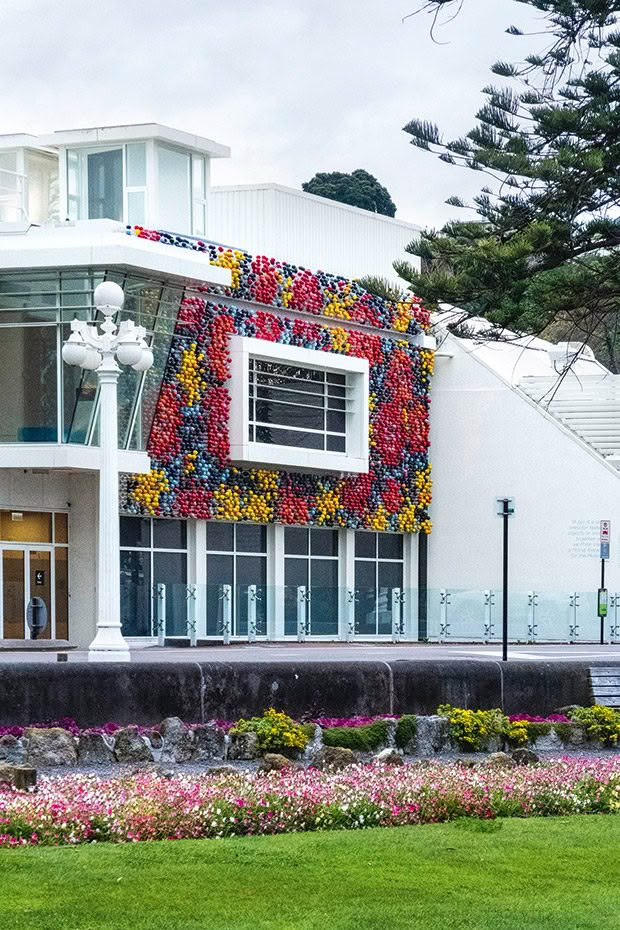
Created from 5000 porcelain glazed balls, the 2015 Pin Cushion wall sculpture by artists Sara Hughes and Gregor Kregor adorns the MTG Hawke’s Bay Museum.
I activate a fountain with my foot, pressing a button, and a nearby nozzle suddenlyspouts a stream upwards, the water splashing down into a shallow basin in the path. It runs aimlessly at first, turning the dry pale concrete into a dark grey puddle, revealing patterns of unfurling fronds etched into the cement.
Napier strives to keep the past present. It’s the lifeblood of the city. And its future is also its past. For the past 30 years, some 40,000 tourists have flocked to Napier for an annual art deco weekend. Napier leverages the grandeur of the past, locking the city into an eternal, enchanting time warp into which I unwittingly fall.
My accommodation is the Masonic Art Deco Hotel, which feels like a period piece from a film set. I enter the lobby, with its graphic red and orange vinyl inlays and richly striped carpets that run up a sweeping stairway.
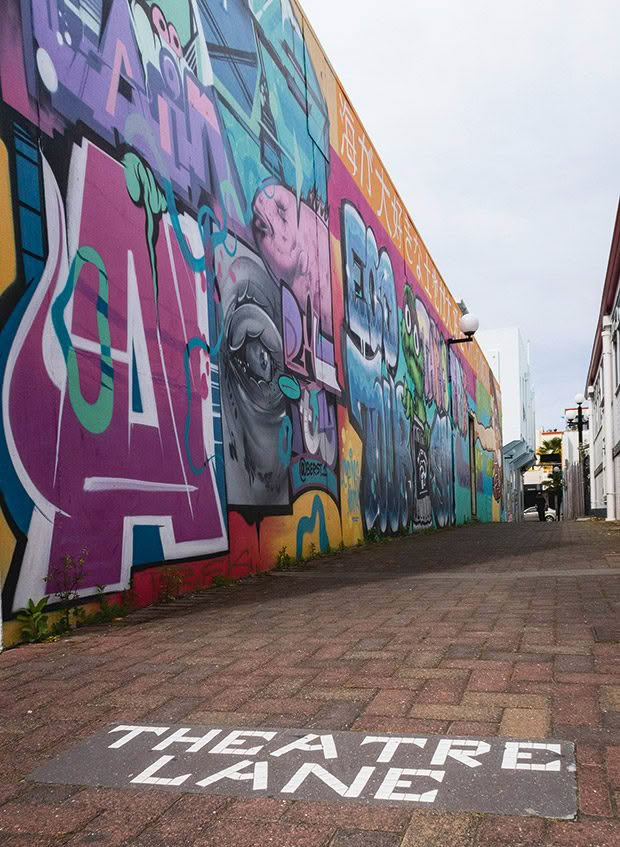
The corridors swish and tinkle with the distant sound of decadence: long-lined, drop-waisted, tube-shaped dresses, flamboyant jewelry of black and gold with sparkles of blue, orange, and yellow. In my track pants and red chequered Swanndri, I’m an anomaly in this carefully choreographed fairy tale. Nonetheless, I feel drawn to participate in the fantasy of a bygone era.
Tucked to one side of The Globe restaurant and bar is a cosy boutique lounge with worn leather sofas and colourful single-seaters that encourage lingering. I stroll inside, ice clinking in my whiskey, and in lampshade light, imagine F. Scott Fitzgerald sitting on
a sofa penning The Great Gatsby. Just past the fireplace, Eileen Grey, sketchbook in hand, is drafting the rough form of her art deco side table.
When I step into the evening, I wander back and forth along the streets that Alfred Domett, in 1885, named after poets and writers: Tennyson, Milton, Emerson, Dickens, Browning, Byron, Shakespeare. I head to Vinci’s pizzeria. The place is foggy and bustling, the pizzas huge. Against one wall is an upright fridge filled with enough boutique beers and wines to satisfy all tastes. Sitting at the bar, looking out the window at an art deco façade, eating my pizza, I begin to think Napier will be forever locked in a nostalgic bubble.
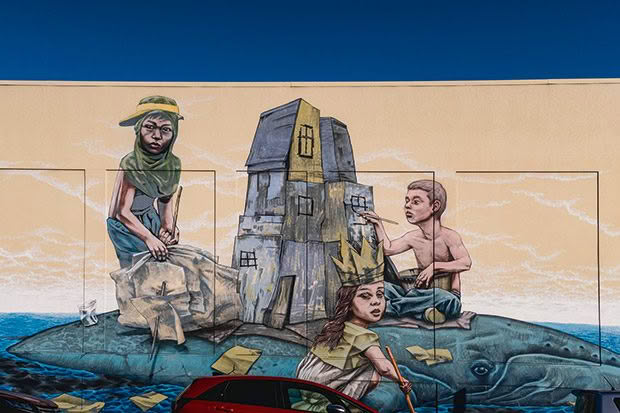
I first glimpse the multicoloured section of Tai Ahuriri wall — a kind of mosaic of reds and blues and blacks and yellows — from across the road, standing next to one of the giant norfolk island pines that line up like sentries along Marine Parade.
As I approach the museum, the colours crystallize into small round balls, the size of tennis balls, adhered to the wall on steel pins. Then I see this nearby: “A pin is a device for fastening objects of material together which we think is a fitting metaphor for the museum.”
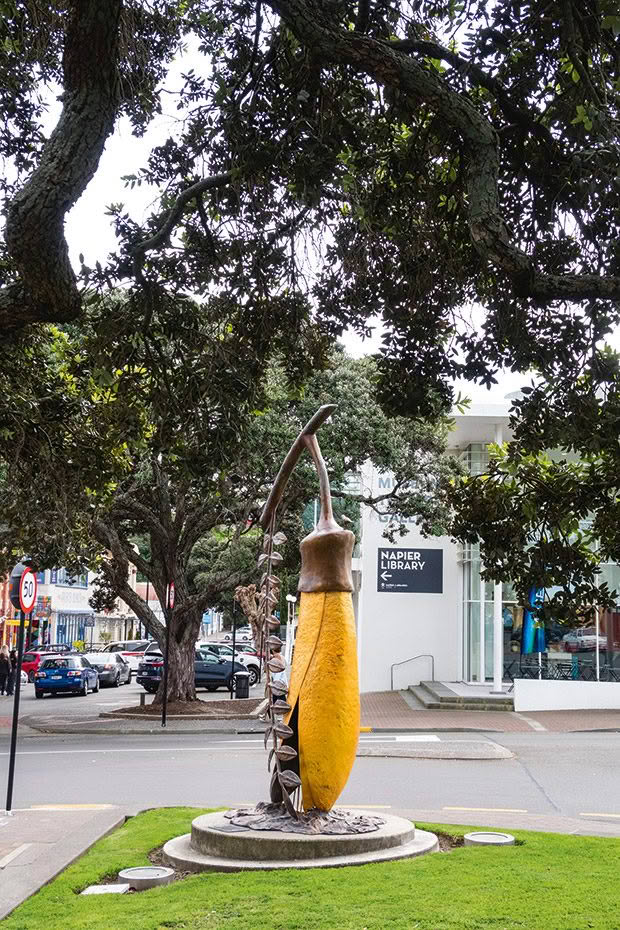
Paul Dibble’s trademark 2014 The Gold of the Kōwhai bronze sculpture resides on a grass.
What I couldn’t see from a distance but is as clear as day now is that this artwork is an assemblage of giant “pins”. Artists Sara Hughes and Gregor Kregor have created a contemporary sculptural artwork called Pin Cushion. I turn and head back towards the beach, smiling.
Born from the rubble and dust 91 years ago, Napier has preserved a moment in time, a bygone era, a flamboyant artistic movement. But there are also seeds of a new art and culture emerging — you can never really stop the clock, not even after an earthquake.
WHAT TO DO
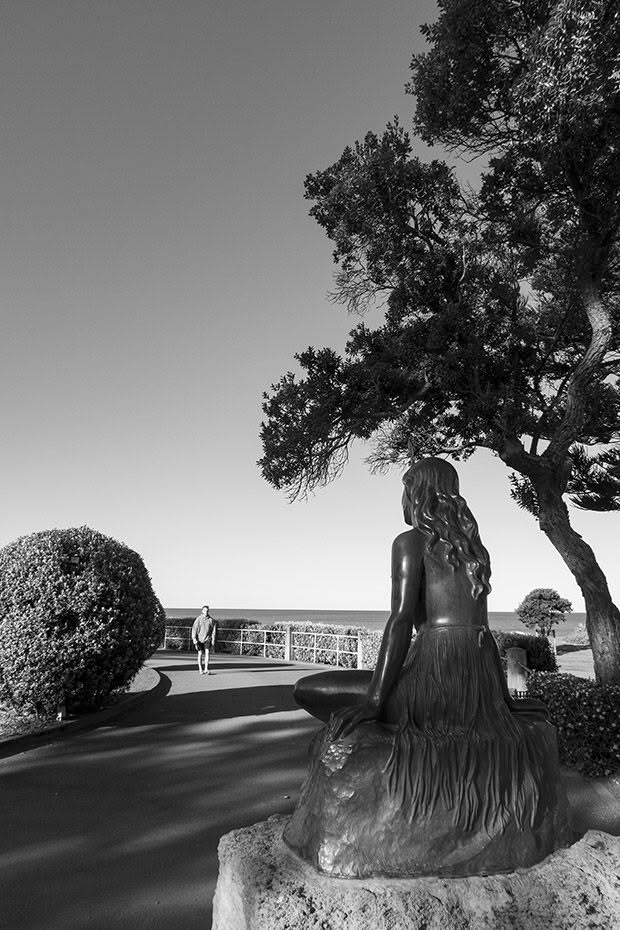
The 1954 bronze statue of Pania is one of Napier’s most-visited attractions. Pania of the Reef casts her gaze over the vast Pacific Ocean.
Ocean Spa: Visit the classic heated pools. There’s a sauna and steam room as well. If you go in the evening, it’s fun to sit with a stream of heated water on your back while looking at the nearby ancient norfolk pines, which are decorated with lights. There’s a gym if you like a workout before a relaxing soak. oceanspanapier.co.nz
MTG Hawke’s Bay Museum and Art Gallery Tai Ahuriri is a must-see for the permanent earthquake exhibition and the excellent contemporary art exhibitions they have. mtghawkesbay.com
Stroll the waterfront: The beach is worth a stroll, especially in the wind. It makes the Pacific Ocean feel extra alive. Visit the nearby sunken gardens and the long stretch of landscaped area that runs parallel to the beach. From here, you can see the six sisters — six small villas — some of Napier’s few remaining examples of Victorian architecture. The millennium sculpture is a 10-minute walk along the beach. The sculpture itself feels a little underwhelming, but it’s fun in the evening to stand at the spot and look at the horizon, where the sun first arose 22 years ago.
The National Aquarium is great if you have children in tow, a glimpse of the underwater world without needing a scuba licence. nationalaquarium.co.nz
Walk the streets of writers and poets: Napier is a walker’s town. Spend a couple of afternoons walking the streets and be amazed at what you can uncover. Pop in and say hi to Holly Morgan in her funky pottery shop, Morganmade. morganmade.co.nz
Art Deco Festival: Not to be missed is Napier’s Art Deco Festival, a chance to escape reality and dive into a few days of fun and fantasy. Book well in advance for hotels/motels. artdecofestival.co.nz
WHERE TO STAY
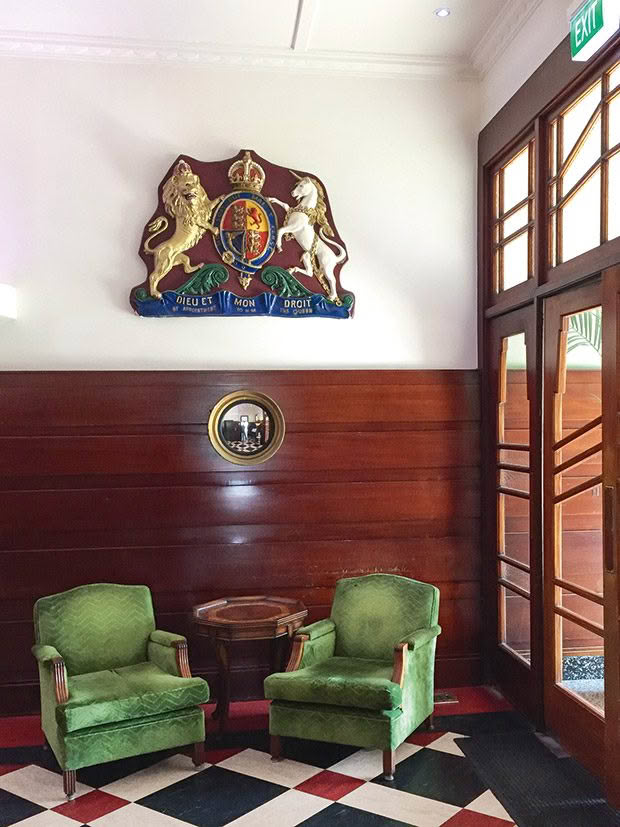
The Masonic Art Deco Hotel is the ideal place to fall into the romance of art deco. It has a large roof deck area looking over the norfolk pines on Marine Parade. It’s a two-minute walk to the beach, museum, gallery and waterfront gardens. Benefit from competitive rates off-season. masonic.co.nz
Criterion Art Deco Backpackers: Try this for something a little lighter on the pocket but still in a central location. criterionartdecobackpackers.com-newzealand.com
WHERE TO EAT
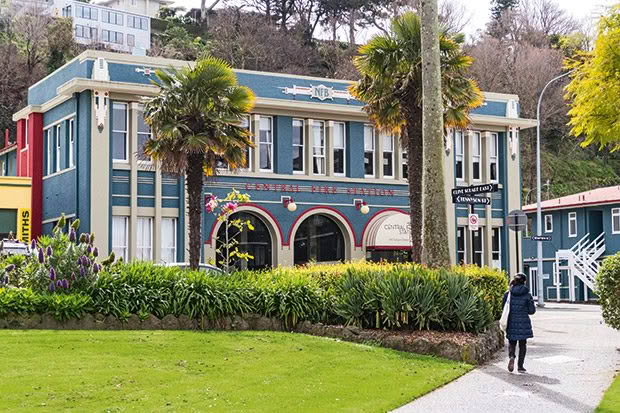
Mister D is a funky café on Tennyson Street that’s definitely worth breakfast. Be prepared for a wait. It can be chaotic, with overflowing patronage. misterd.co.nz
The Central Fire Station Bistro has a varied menu. And yes, there’s a fireman’s pole behind reception. The bistro showcases Hawke’s Bay produce, and it pays to book — or be turned away. centralfirestation.co.nz
The Globe restaurant and bar is connected to the Masonic Art Deco Hotel. As the name suggests, it has a globe-trotting menu with tastes from Africa, America, Asia, Europe and Oceania. It’s a fun place to dine, with smart décor. There’s a large events area, which can crowd the place out from time to time. globerestaurant.co.nz
Cafe Tennyson Bistro is a great place for a brekky — but, be warned, it gets busy. You can sit outside in the sun on the footpath or upstairs on the second floor. cafe-tennyson.com
If you’re a coffee lover, Thirdeye Coffee is a must-visit for caffeine. The owners roast their own beans and are on a mission to expand. Buy their beans if you want to take the experience home. thirdeyecoffee.nz
Vinci’s Pizzeria: The size of the pizzas alone is worth the experience. Boutique beers and interesting wines are nearby to wash them down. vincispizza.co.nz
Love this story? Subscribe now!
 This article first appeared in NZ Life & Leisure Magazine.
This article first appeared in NZ Life & Leisure Magazine.
